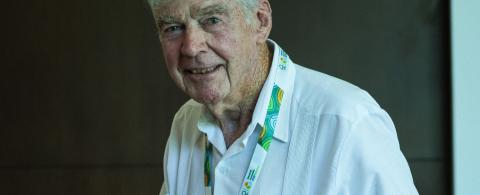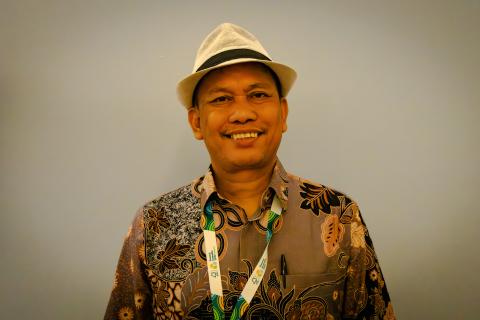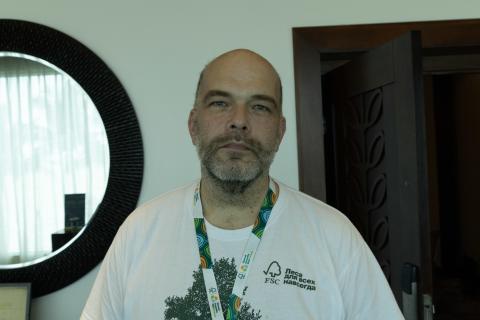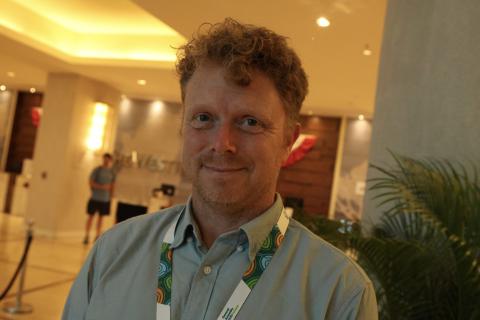How to orchestrate the world’s largest FSC print run
Two years ago, sustainability specialist of Inter IKEA Systems Matthieu Leroy faced the daunting task of achieving FSC certification of all IKEA catalogues worldwide. Following a successful process, each of the 217 million copies will carry the FSC label this year. Whilst procuring 100,000 tonnes of FSC paper was surprisingly easier than expected, it required a task force to comply with the FSC requirements and trademark guidelines.
 “As part of our sustainability strategy, IKEA focuses on FSC certification for assuring a responsible origin of wood fibres. This is why we ask our suppliers to deliver FSC certified paper,” says Inter IKEA Systems sustainability specialist Matthieu Leroy.
“As part of our sustainability strategy, IKEA focuses on FSC certification for assuring a responsible origin of wood fibres. This is why we ask our suppliers to deliver FSC certified paper,” says Inter IKEA Systems sustainability specialist Matthieu Leroy.
As worldwide IKEA franchisor, Inter IKEA Systems plays a key role in the branding and promotion of IKEA globally. This includes coordinating the world’s largest print run, the IKEA catalogue. Tasked with the goal of achieving FSC labelling for the entire catalogue production, the organisation launched a project involving several challenging steps.
“Mission impossible” proved realistic
In March 2014, Inter IKEA Systems obtained FSC Chain of Custody certification from the Rainforest Alliance, based on NEPCon’s auditing. Inter IKEA Systems procures and takes ownership of the 100,000 tonnes of paper going into the production of the IKEA catalogue. The certification was therefore a required part of the road map towards FSC labelling.
“The certification process was quite fast,” remarks Mr Leroy. “We took a formal decision to seek certification end of January 2014, and by March 2014 we had the certificate.”
There were two other preconditions that Inter IKEA Systems needed to fulfil: They must have access to sufficient certified paper supplies, and their print suppliers must have FSC certification in place covering the right scope.
Mr Leroy: “Every year, we organise a supply meeting gathering together all our paper and print suppliers. Two years ago, we announced our ambition to source 100% FSC mix credit paper for the IKEA catalogues within three years.”
Initially, the reaction was sceptical. IKEA’s ambition was seen as mission impossible. ”We were met with three main objections to this plan: 1. There was not enough FSC paper to fulfil our ambition. 2. It would be too costly. 3. It was impossible to achieve this in three years’ time,” explains Mr Leroy.
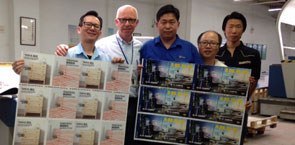 ”But in fact, all of them turned out to be wrong. There was indeed enough FSC paper, the cost hasn’t risen as expected, and we achieved our goal one year ahead of schedule. We moved from 23% FSC certified paper to 68 % in the first year, and to 100 % in the following year.”
”But in fact, all of them turned out to be wrong. There was indeed enough FSC paper, the cost hasn’t risen as expected, and we achieved our goal one year ahead of schedule. We moved from 23% FSC certified paper to 68 % in the first year, and to 100 % in the following year.”
IKEA’s push for certified has had business consequences for some suppliers.
”We’ve had to phase out suppliers who were unable to meet our demands. In one case, we discovered that the supplier’s FSC certificate had been suspended. Others have had to expand the scope of their certificate,” explains Mr Leroy.
He hopes that Inter IKEA Systems can help others by sharing their experience. ”I believe that many other printing processes in the world could be FSC certified”, he says. ”If we could do this, for sure others can do it too.”
NEPCon Executive Director Peter Feilberg says: “I commend Inter IKEA Systems for their efficiency in preparing for certification as well as in achieving actual FSC labelling of their catalogues. It’s a massive feat that has clearly required determination, good supplier communication and strong process management. This is a significant milestone on IKEA’s path towards sourcing of paper, packaging and furniture with a responsible origin.”
The challenge of FSC labelling
According to Mr Leroy, achieving CoC certification, procuring 100,000 tonnes of FSC paper and working with 32 printing houses to ensure eligibility for FSC labelling were not the most challenging parts as originally expected. The difficult part was to communicate the consequences of being FSC certified to other internal stakeholders involved in the catalogue production.
Mr Leroy: ”The process became challenging when we started to communicate and create the artwork. In our 2015 catalogues, one-third of a full page talks about the FSC certification. Getting that part right took a significant amount of time and effort that was not expected.”
The on-product labelling in particular proved to require an unexpected amount of resources. ”To follow the FSC trademark rules really was one of the biggest challenge we faced,” he says.
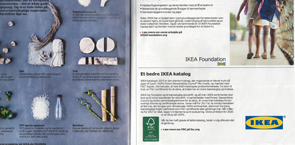 ”Due to sudden changes in the FSC trademark rules [TM and ®] when we had already finalised the artwork, some of our printers came back to us while they had started printing and said that the artwork was wrong.” NEPCon and Inter IKEA Systems engaged in a dialogue with FSC to resolve the issue. In the end, FSC granted a derogation permitting the distribution of some catalogues that were already in the making.
”Due to sudden changes in the FSC trademark rules [TM and ®] when we had already finalised the artwork, some of our printers came back to us while they had started printing and said that the artwork was wrong.” NEPCon and Inter IKEA Systems engaged in a dialogue with FSC to resolve the issue. In the end, FSC granted a derogation permitting the distribution of some catalogues that were already in the making.
Mr Leroy adds:” Next year, we will be better prepared as we’ve set up a trademark task force and produced simple internal labelling guidelines. I also think that FSC needs to learn the complex set-up and processes of such a production. For example, communicating changes and allowing a proper phase-in time would be a great improvement. I hope that by working together with FSC in a mutual learning process, we can help to improve the system.”
Follow Matthieu Leroy on Twitter @maleroy
IKEA’s supplier programme
The goal of IKEA is that by August 2017, at least 50% of their wood will come from more sustainable sources. These sources are currently defined as FSC certified or recycled wood. Today’s figure (as of April 2014) is 40%. The long-term goal is to reach 100 %. |
About Inter IKEA Systems
Inter IKEA Systems B.V. is the owner of the IKEA Concept and the worldwide IKEA franchisor. The assignment is to continuously develop the IKEA Concept and to ensure its successful implementation in existing and new markets. This for instance includes coordinating the production of the printed and digital IKEA catalogues.
The FSC license code of Inter IKEA Systems B.V. is FSC™ C120450. Find more information about the certificate.
